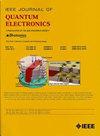High-Precision Triangular Waveform With Tunable Symmetry Photonic Generation Based on Image-Reject Down Conversion
IF 2.1
3区 工程技术
Q3 ENGINEERING, ELECTRICAL & ELECTRONIC
引用次数: 0
Abstract
A high-precision triangular waveform with tunable symmetry photonic generation scheme based on in-phase/quadrature-phase modulation and image-reject down conversion is proposed and analyzed. The optical carrier from the laser diode is split into two paths: one is injected into the I/Q modulator driven by a sinusoidal signal, while the other is injected into a frequency shifter to introduce a frequency offset. Different channels have different frequency offsets. The modulated and frequency-shifted signals enter the image-reject mixer to realize optical down conversion and suppress the frequency mixing interference in the frequency conversion process. Finally, the signals from both channels are coupled to synthesize the first to sixth-order harmonic fitting in the Fourier series. High-precision triangular waveforms generation with tunable symmetry coefficients and repetition frequency of 5 GHz are obtained by simulation. In order to verify the mechanism, a proof-of-concept experiment is carried out. This scheme effectively expands the multi-channel spectrum and enables high-precision functional waveform fitting.基于图像抑制下转换的可调对称光子生成高精度三角波形
提出并分析了一种基于同相/正交相位调制和图像抑制下变频的高精度三角波形可调对称光子产生方案。来自激光二极管的光载波被分成两条路径:一条被注入到由正弦信号驱动的I/Q调制器中,而另一条被注入到移频器中以引入频率偏移。不同的信道有不同的频率偏移。经过调制和移频的信号进入图像抑制混频器,实现光下转换,抑制变频过程中的混频干扰。最后,对两个通道的信号进行耦合,合成傅里叶级数的一阶到六阶谐波拟合。仿真得到了对称系数可调、重复频率为5 GHz的高精度三角波形。为了验证该机制,进行了概念验证实验。该方案有效地扩展了多通道频谱,实现了高精度的函数波形拟合。
本文章由计算机程序翻译,如有差异,请以英文原文为准。
求助全文
约1分钟内获得全文
求助全文
来源期刊

IEEE Journal of Quantum Electronics
工程技术-工程:电子与电气
CiteScore
4.70
自引率
4.00%
发文量
99
审稿时长
3.0 months
期刊介绍:
The IEEE Journal of Quantum Electronics is dedicated to the publication of manuscripts reporting novel experimental or theoretical results in the broad field of the science and technology of quantum electronics. The Journal comprises original contributions, both regular papers and letters, describing significant advances in the understanding of quantum electronics phenomena or the demonstration of new devices, systems, or applications. Manuscripts reporting new developments in systems and applications must emphasize quantum electronics principles or devices. The scope of JQE encompasses the generation, propagation, detection, and application of coherent electromagnetic radiation having wavelengths below one millimeter (i.e., in the submillimeter, infrared, visible, ultraviolet, etc., regions). Whether the focus of a manuscript is a quantum-electronic device or phenomenon, the critical factor in the editorial review of a manuscript is the potential impact of the results presented on continuing research in the field or on advancing the technological base of quantum electronics.
 求助内容:
求助内容: 应助结果提醒方式:
应助结果提醒方式:


